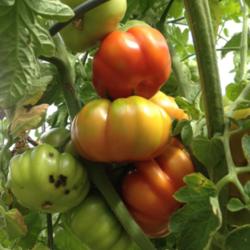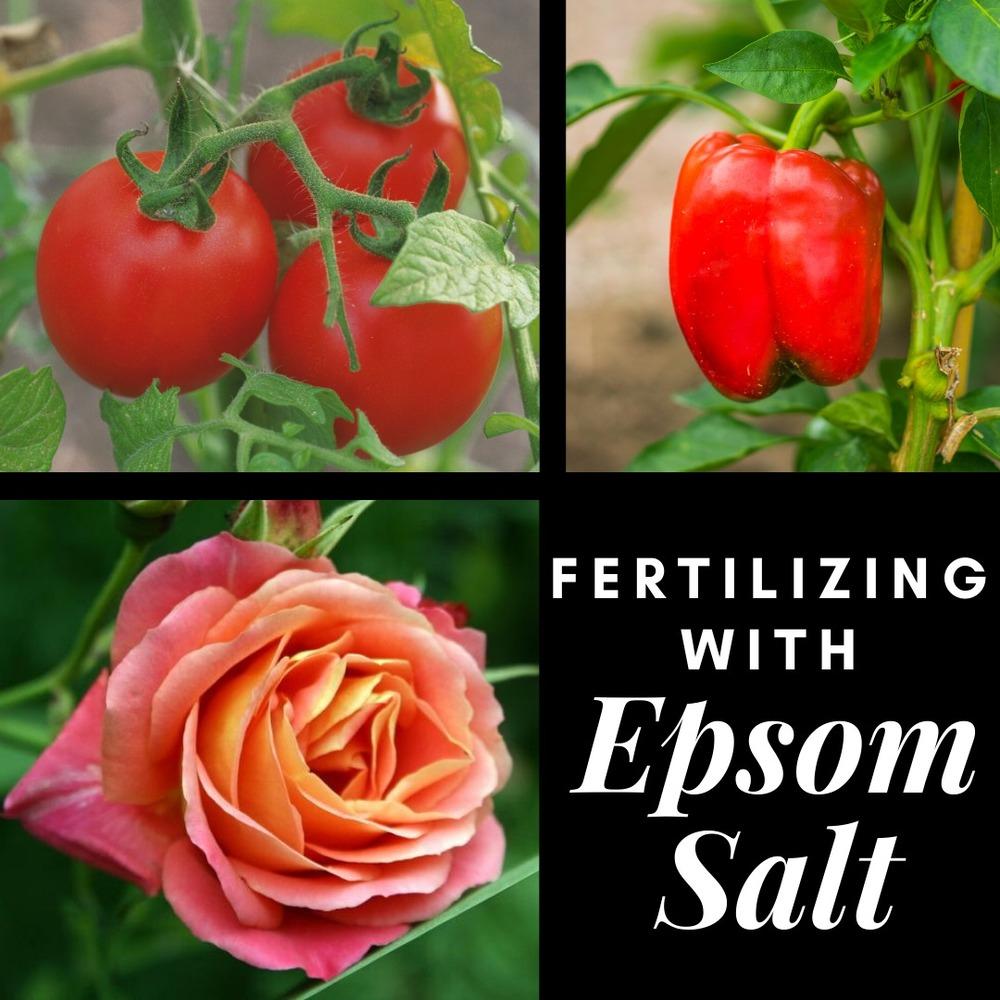
After working with home gardeners for more than 10 years, I know that they love to use home remedies on their plants. From setting out beer traps for slugs to hanging bars of soap to repel deer, if the household product seems to work, gardeners try it. That's why I was intrigued by the often-mentioned idea of using Epsom salts as a fertilizer.
Gardeners apply it to tomatoes, peppers, and roses, hoping to produce more flowers, greener plants, and higher yields. You can use it to improve magnesium content if you know you have a soil that's deficient in that element, but home gardeners are most likely to apply Epsom salts to peppers, tomatoes, and roses.
I wanted to find out if it really works and learn the best ways to apply it for best growth, so last summer I asked some of our test gardeners (home gardeners who tested seeds and products for National Gardening) to test Epsom salts' effects on plant growth and vigor by applying it to pepper plants and roses. Then I talked to researchers about using the salts as fertilizer. Here's what I found out.
The History and Science of Epsom SaltsThis natural mineral, discovered in the well water of Epsom, England, has been used for hundreds of years, not only to fertilize plants but to treat a range of human and animal ailments. Who hasn't soaked sore feet in it at least once?
Chemically, Epsom salts is hydrated magnesium sulfate (about 10 percent magnesium and 13 percent sulfur). Magnesium is critical for seed germination and the production of chlorophyll, fruit, and nuts. Magnesium helps strengthen cell walls and improves plants' uptake of nitrogen, phosphorus, and sulfur.
Sulfur, a key element in plant growth, is critical to production of vitamins, amino acids (therefore protein), and enzymes. It's also the compound that gives vegetables such as broccoli and onions their flavors. Sulfur is seldom deficient in garden soils in North America because acid rain and commonly used animal manures contain sulfur, as do chemical fertilizers such as ammonium sulfate.
The causes and effects of magnesium deficiencies vary. Vegetables such as beans, peas, lettuce, and spinach can grow and produce good yields in soils with low magnesium levels, but plants such as tomatoes, peppers, and roses need high levels of magnesium for optimal growth. However, plants may not show the effects of magnesium deficiency until it's severe. Some common deficiency symptoms are yellowing of the leaves between the veins, leaf curling, stunted growth, and lack of sweetness in the fruit.
Magnesium tends to be lacking in old, weathered soils with low pH, notably in the Southeast and Pacific Northwest. Soils with a pH above 7 and soils high in calcium and potassium also generally have low magnesium levels. Calcium and potassium compete with magnesium for uptake by plant roots, and magnesium often loses. Sometimes, a soil test will show adequate magnesium levels in soil, but a plant grown in that soil may still be deficient because of that competition.
Gardeners add magnesium when they apply dolomitic lime to raise the soil's pH. However, this product (46 percent calcium carbonate, 38 percent magnesium carbonate) breaks down slowly, and the calcium can interfere with magnesium uptake. For soils with a pH above 7, many gardeners use Sul-Po-Mag (22 percent sulfur, 22 percent potassium, 11 percent magnesium) to increase magnesium. Although dolomitic lime and Sul-Po-Mag are inexpensive ways to add magnesium, Epsom salts' advantage over them is its high solubility.
When diluted with water, and especially when applied as a foliar spray, Epsom salts can be taken up quickly by plants. Epsom salts' magnesium content, high solubility, and ease of application as a foliar spray are the main reasons for the positive results many gardeners see in their plants.
What Our Testers FoundTo get a first-hand look at the effectiveness of Epsom salts in the garden, we asked six of our testers (in California, Colorado, Iowa, Pennsylvania, and Tennessee) to try Epsom salts on peppers and roses. Testers each grew six 'Gypsy' peppers. They applied 1 tablespoon of Epsom salts mixed with a gallon of water as a foliar spray to three plants at bloom time and again 10 days later. They also selected two established rose bushes of the same variety and sprayed the same amount of Epsom salts mixed with water to one bush every 6 weeks, starting when leaves came out and continuing through the summer (about 4 applications). We asked them to record the number of pepper fruits and rose blooms, and to note any differences they saw.
Four out of the six testers reported that the Epsom salts-treated pepper plants and fruits were larger than the controls. For the treated roses, testers reported greener foliage, bushier plants, and more roses than on the control plants.
Kathy Stone Downie of Alameda, California, noticed many differences in her treated 'Gypsy' peppers. "The fruits were much bigger, almost twice the size. They were juicier, sweeter, and triple the thickness of the untreated peppers." Tommy Owen, in Rogersville, Tennessee, said that his treated roses had greener foliage and bigger flowers with deeper colors.
Recent Studies of Epsom SaltsScientists are beginning to test its use. Although many studies confirm that magnesium sulfate is a good way to supply magnesium and sulfur to soils deficient in those elements, little research has been done on the use of Epsom salts as a supplemental fertilizer on soils with adequate levels of these nutrients.
Renee Schloupt, horticulturist at Delaware Valley College in Doylestown, Pennsylvania, is testing peppers and tomatoes grown in a greenhouse environment under drought and nondrought conditions. She's comparing control plants with those watered with applications of 1, 2, and 3 tablespoons of Epsom salts mixed with 1 gallon of water and applied at planting, flowering, and fruit set. So far, she has not seen any measurable evidence of growth or yield differences in the treated tomatoes or peppers. "The peppers have greener leaves, and it seems the 1- and 2-tablespoon doses yield a better result than the 3-tablespoon dose, but I haven't seen any dramatic effects on yields so far," she says. "The magnesium in the Epsom salts applied to the soil could be getting tied up with other nutrients. We might see better results when we apply Epsom salts directly to the leaves."
At Auburn University in Alabama, plant pathologist Kira Bowen and soil scientist Beth Guertal see similar results when they apply Epsom salts directly on the soil. They are conducting a 3-year study of roses in field plots that includes applying 1 cup of Epsom salts per plant per month as one of the treatments to increase plant vigor and control black spot. "The first year, we saw reduced defoliation in the Epsom salts-treated plants, but the second year the differences weren't there," Bowen reports. "It's hard to find a direct link between a specific nutrient such as magnesium sulfate and increased yield or plant growth because of all the other variables in the soil, such as pH, calcium and potassium content, and weather, that may affect the plants."
Is Using Epsom Salts Worth a Try?In their studies, researchers applied Epsom salts directly to the soil. Foliar applications, such as those our test gardeners used, appear to be a better way to guarantee that the plants get the benefits of the added magnesium.
Before you try Epsom salts, test the soil to determine its magnesium content. Don't rely on Epsom salts to correct large soil magnesium deficiencies, but rather use it as a supplement to soils with adequate or slightly low magnesium levels to boost plant growth, flowering, and fruiting. For severely magnesium-deficient soils, use dolomitic lime or Sul-Po-Mag. Foliar applications of Epsom salts seem work better than adding it, dry or mixed with water, directly to the soil. Plants may not efficiently take up magnesium sulfate in granular form, especially in alkaline soils or soils that already test high in potassium, calcium, or magnesium. If you have tested your soil and know it has those qualities, a foliar application is a faster way to get the nutrients to the plant.
RosesMany rosarians agree that Epsom salts-treated planats produce more new canes at the bottom of the plant (bottom breaks) and darker green foliage. Recommendations on how much to use vary, but generally you can apply 1/2 cup of granules in spring before buds first begin to open and 1/2 cup in fall before leaves drop. Apply a foliar spray (1 tablespoon per gallon of water per foot of shrub height) after the leaves open in spring and again at flowering.
Tomato and PeppersMagnesium deficiency in the soil may be one reason your tomato leaves yellow between the leaf veins late in the season and fruit production slows down. Test your soil every 3 years or so to check on nutrient levels. Epsom salts can keep plants greener and bushier, enhance production of healthier fruit later in the season, and potentially help reduce blossom-end rot in magnesium-deficient soils. [Editor's note: Maybe not. Read this comment for an another view on this topic.] Apply 1 tablespoon of granules around each transplant, or spray a solution of 1 tablespoon Epsom salts per gallon of water at transplanting, first flowering, and fruit set.
Epsom salts is available in drug and grocery stores.
Epsom salts works best on soils that are...
Charlie Nardozzi is a senior horticulturist at National Gardening.

 Charlie Nardozzi is an award winning, nationally recognized garden writer, speaker, radio, and television personality. He has worked for more than 30 years bringing expert gardening information to home gardeners through radio, television, talks, tours, on-line, and the printed page. Charlie delights in making gardening information simple, easy, fun and accessible to everyone. He's the author of 6 books, has three radio shows in New England and a TV show. He leads Garden Tours around the world and consults with organizations and companies about gardening programs. See more about him at Gardening With Charlie.
Charlie Nardozzi is an award winning, nationally recognized garden writer, speaker, radio, and television personality. He has worked for more than 30 years bringing expert gardening information to home gardeners through radio, television, talks, tours, on-line, and the printed page. Charlie delights in making gardening information simple, easy, fun and accessible to everyone. He's the author of 6 books, has three radio shows in New England and a TV show. He leads Garden Tours around the world and consults with organizations and companies about gardening programs. See more about him at Gardening With Charlie.
 Victory Seed Company has all the seeds you want for your best garden in 2024.
Victory Seed Company has all the seeds you want for your best garden in 2024.
For 25 years, the family-owned Victory Seed Company has provided the highest quality vegetable, herb and flower seeds to families across the country. We are passionate about providing you the best seeds available that give excellent germination, robust plants, and the harvest you want. With a catalog of over a thousand varieties, we have everything, and our prices are the kinds that we'd want to pay. We have hundreds of yesterday's heirloom vegetables, as well as today's award winning hybrid selections. Get to know us by visiting our website and browsing through our online vegetable seed catalog.